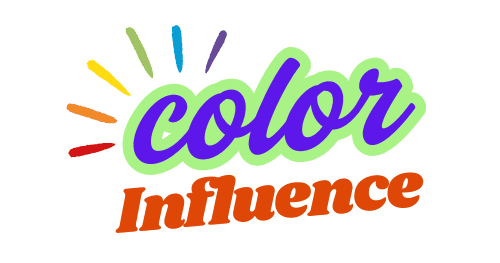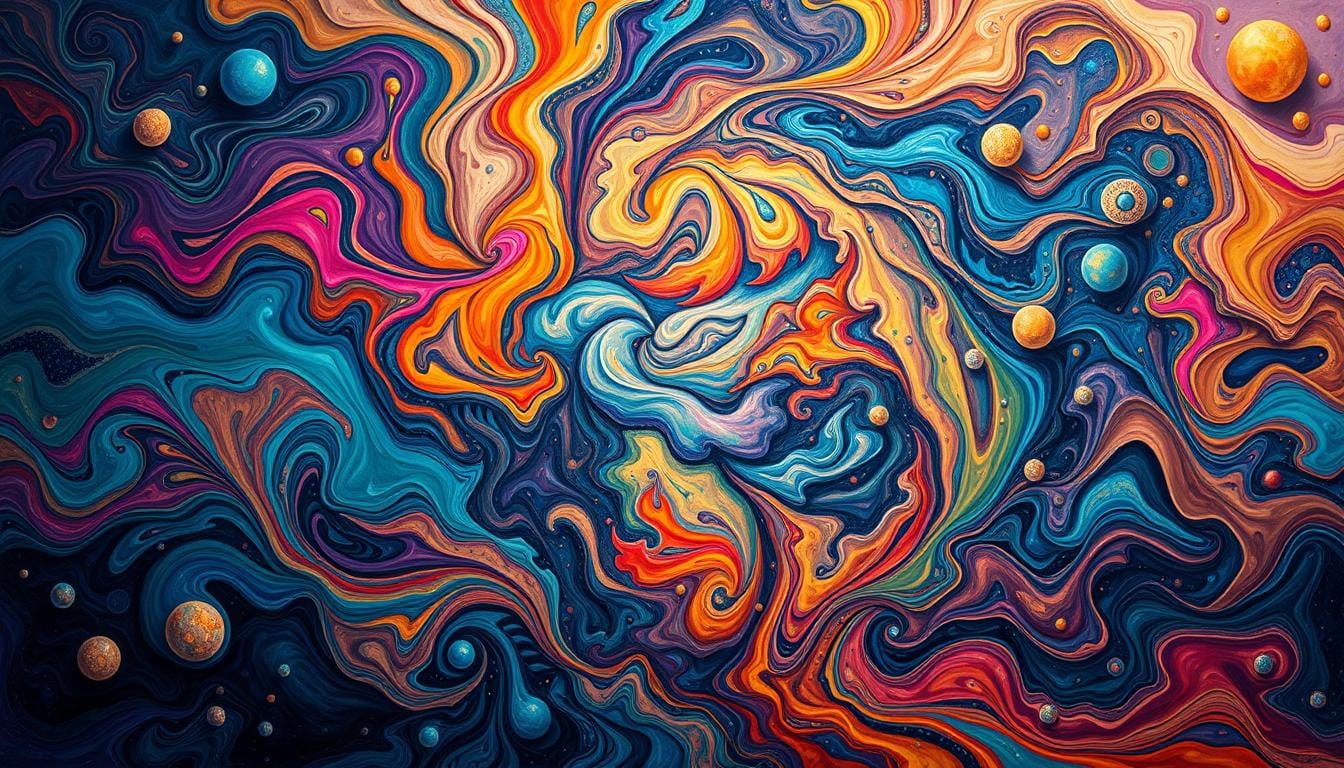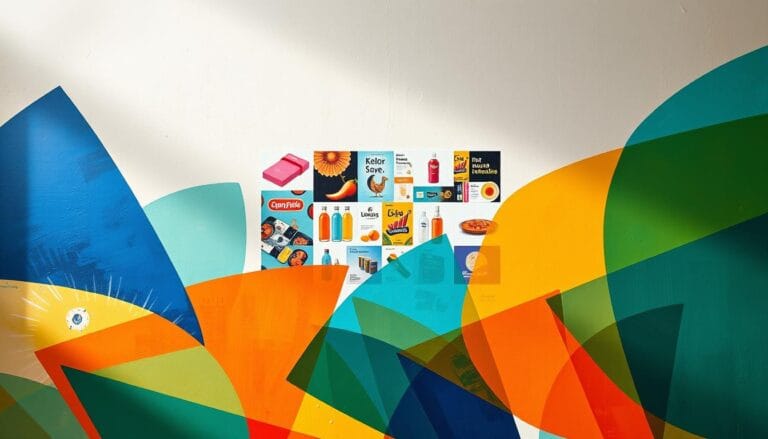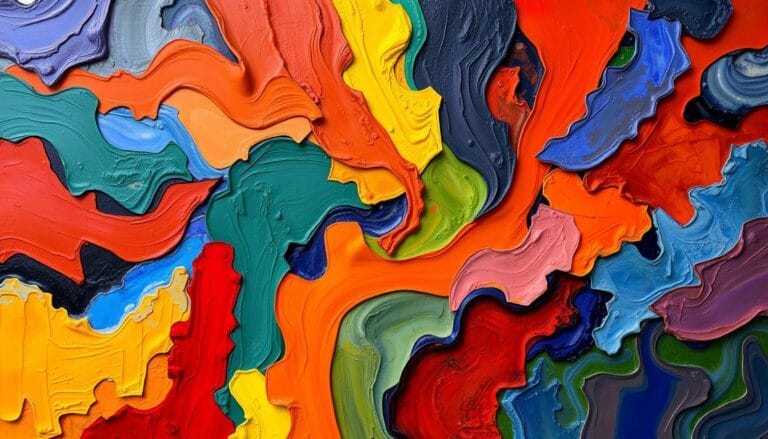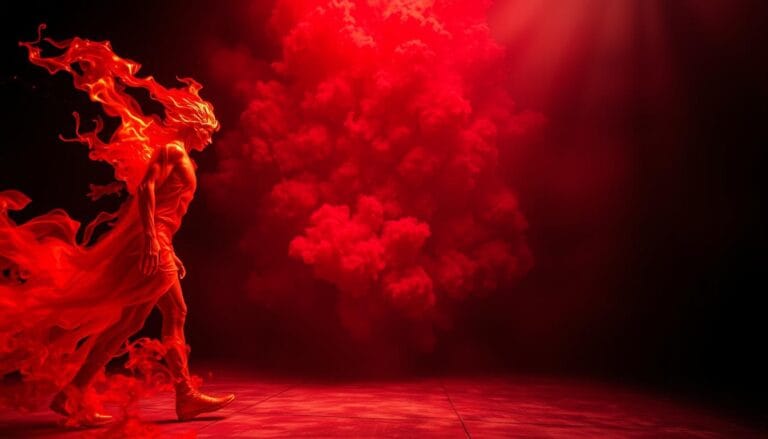Colors of the Mind: How Different Hues Boost Creativity and Enhance Focus
Ever wondered why some colors energize you while others calm you down? The world of visual perception shows how colors deeply affect our minds. Colors of the Mind is more than a concept—it’s a tool that can change how we think, feel, and create.
Color theory tells us each color has its own effect on our minds. For example, red boosts energy, while blue helps us focus. Colors are not just what we see; they talk to our brain, influencing our thoughts in amazing ways.
Picture entering a room painted in soft blue. Studies say this color can lower anxiety by 33% and improve thinking. This is the power of color psychology—a science that explores how colors shape our minds and feelings.
Understanding Color Psychology: The Science Behind Visual Perception
Color psychology looks at how colors affect our minds. It shows how our brains interpret colors in a deep way. This goes beyond just seeing colors and involves complex thinking and learning.
For thousands of years, people have known about color’s power. Ancient cultures used colors in healing and spiritual rituals. They saw how colors could change emotions and actions.
The Evolution of Color Psychology Research
Research on color psychology has uncovered many interesting facts. Key moments include:
- Early Egyptian color therapy practices (2000 BC)
- Goethe’s Theory of Colors in 1810
- Kurt Goldstein’s experimental work in 1942
- Modern neurological studies exploring color perception
Key Principles of Color Theory and Mental Processing
Our brains process colors through complex paths. The human eye has three types of cone cells. These cells help us see colors in detail.
| Cone Cell Sensitivity | Wavelength | Perception Impact |
|---|---|---|
| Blue Cones | 445 nm | Calming, reduces stress |
| Green Cones | 535 nm | Promotes relaxation |
| Red Cones | 565 nm | Increases alertness |
How Brain Processes Color Information
Studies show that color perception involves many brain areas. The opponent process theory explains how our brains process colors in pairs. This leads to complex emotional and psychological responses.
Color is not just a visual experience, but a profound psychological journey that connects perception, emotion, and cognitive processing.
The Fundamental Impact of Warm vs. Cool Colors
Colors have a big impact on how we see and feel our surroundings. They are not just something we see. They also affect our emotions and thoughts deeply.
Warm colors like red, orange, and yellow make us feel alive. Studies show that:
- 52% of people feel joy when they see yellow
- Warm colors catch our attention better than cool colors
- They can make our heart rate go up by about 10 beats per minute
Cool colors, such as blue, green, and purple, have a calming effect. They make us feel calm and distant. Research also shows that:
- Cool colors can lower anxiety by 20-30%
- They make things look bigger and more open
- They help us focus and remember things better
Colors speak a language deeper than words, communicating directly with our emotions and subconscious mind.
Color perception is not always straightforward. A red-violet might seem cooler next to red but warmer next to blue. This shows how complex color psychology can be.
Knowing how warm and cool colors work can help us use them in different ways. We can use them to change mood, spark creativity, and improve mental performance in various places.
Colors of the Mind: Emotional and Psychological Responses
Colors of the Mind show us a world where colors deeply affect our feelings and minds. Learning about how colors influence us can help us understand mindfulness and emotional smarts better.
Colors and emotions are closely linked, more than just seeing them. Studies show certain colors can change our mood, energy, and how well we think.
Red: The Color of Energy and Attention
Red is a strong color that affects us deeply. Research found that:
- 68% of participants associate red with love
- Red increases heart rate and stimulates quick thinking
- Wearing red can boost perceived attractiveness
Blue: The Shade of Focus and Tranquility
Blue is calming and helps us focus. Interesting facts include:
- 35% of people connect blue with relief
- Blue light exposure impacts melatonin levels
- People sleep an average of 7 hours and 52 minutes in blue bedrooms
Yellow: Stimulating Creative Energy
Yellow is full of creative energy. Key findings are:
- 52% of respondents link yellow with joy
- Yellow is the most attention-grabbing color
- It can potentially increase concentration
“Colors speak a language deeper than words, communicating directly with our emotions and subconscious mind.”
Knowing about color psychology can help us create spaces that support our mental and emotional health.
How Colors Influence Workplace Productivity
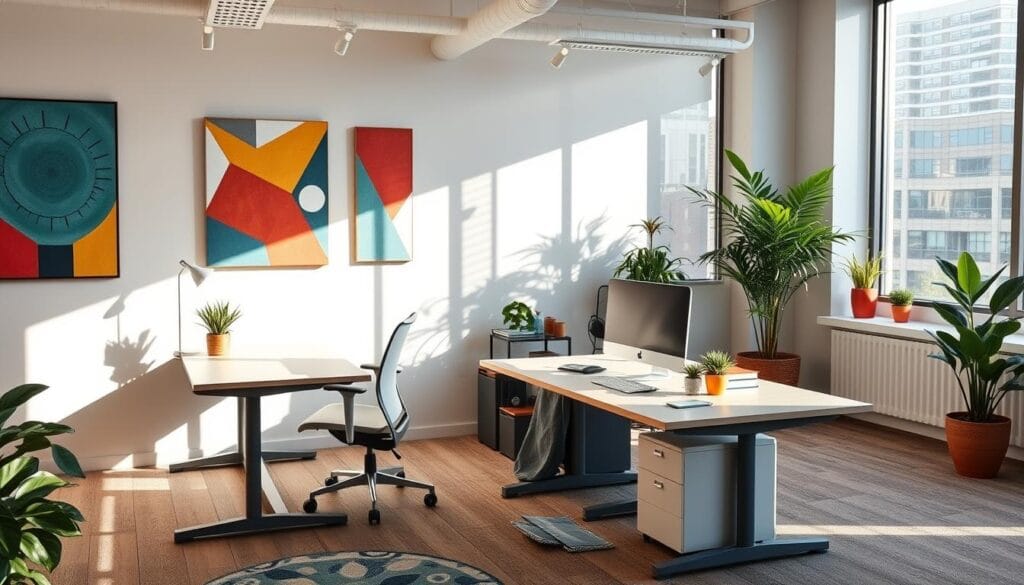
Color psychology can change your workplace for the better. It can make your team more productive. Studies show that picking the right colors can really make a difference.
Colors shape how we feel and work together. Each color can make us think and feel differently. This affects how well we do our jobs and how happy we are at work.
“Color is a powerful communication tool that can signal action, influence mood, and impact workplace effectiveness.” – Color Psychology Expert
- Blue promotes focus and calm
- Yellow stimulates creativity
- Red energizes physical activities
- Green reduces workplace stress
Research shows that colors can make us work better. For example, blue can make our heart rate slow down and help us concentrate. It’s great for tasks that need a lot of detail.
| Color | Psychological Impact | Workplace Benefit |
|---|---|---|
| Blue | Calming | Improved Focus |
| Yellow | Energetic | Enhanced Creativity |
| Green | Relaxing | Stress Reduction |
| Red | Stimulating | Physical Energy |
Choosing colors wisely can make your workplace not just look good but also help your mind work better. By knowing how colors affect us, you can create spaces that boost productivity and happiness.
The Role of Color in Learning and Academic Performance
Color and learning are closely linked. Cognitive psychology shows that colors are more than just what we see. They are tools that shape our mental images and focus in school.
Colors are key in how we learn and remember. Studies show that using colors wisely can really help students do better in school.
Color-Coding for Enhanced Memory Retention
Using colors to organize learning can make a big difference. Students can use these methods in many ways:
- Creating color-coded notes
- Using visual diagrams with distinct color schemes
- Organizing study materials with color-specific categorization
Optimal Colors for Study Spaces
Choosing the right colors for study areas is important. Each color can affect our mood and focus differently:
| Color | Cognitive Effect | Learning Impact |
|---|---|---|
| Green | Reduces Anxiety | Improves Focus |
| Blue | Calms Mind | Enhances Logical Reasoning |
| Yellow | Stimulates Nervous System | Boosts Optimism |
Impact on Test Performance and Concentration
Colors can affect how well we do on tests. Specific colors can help manage stress and improve focus. For example, green or blue backgrounds can help calm us down and keep our minds clear during tough tasks.
“Colors speak a language more profound than words, guiding our cognitive processes in learning.” – Color Psychology Research Institute
By using colors wisely, you can make your learning space better. This can help you reach your full potential and succeed in school.
Cultural and Personal Color Associations
Color symbolism changes a lot across different cultures. It shows how our feelings about colors can be very personal and tied to our surroundings. What one person sees in a color might be very different from someone else’s view.
Let’s look at some interesting color meanings in different cultures:
- In China, red means good luck and wealth
- In Western cultures, white is seen as pure
- But in Eastern cultures, white is a color for mourning
- In ancient Egypt, blue was a symbol of protection
“Colors speak a language more universal than words, yet deeply personal to each culture.”
Your own life experiences also affect how you see colors. Colors and emotions are connected in a special way for each person. What brings happiness to one might mean something else to another.
Studies show that color meanings are not the same everywhere. They are shaped by:
- Cultural background
- Personal experiences
- Where you live
- History
Knowing about these color meanings can help you in work and creative projects. It lets you make choices that are more meaningful and respectful.
Using Color Psychology for Enhanced Creativity
Unlocking your creative potential is more than just brainstorming. Colors of the Mind can spark new ideas and mental images. Knowing how colors affect our minds can change how we think creatively.
Neuro-linguistic programming shows that colors deeply impact our mood and creativity. Here are some ways to use color in your creative work.
Color Techniques for Brainstorming
Try these color-based methods for idea generation:
- Use blue backgrounds to enhance creative thinking and focus
- Incorporate yellow accents to stimulate mental energy
- Experiment with green elements to promote calm and innovative thinking
Creating Color-Optimized Creative Spaces
Design your space to boost creativity with these tips:
| Color | Creative Impact | Recommended Space |
|---|---|---|
| Blue | Boosts concentration | Home office |
| Yellow | Stimulates innovation | Studio workspace |
| Green | Promotes calm creativity | Reading nook |
“Color is a power which directly influences the soul.” – Wassily Kandinsky
Studies from the University of Minnesota show color’s impact. Blue and green spaces can improve focus by 25%. Yellow areas can increase creativity by 15%. Choosing the right colors for your space can greatly improve your mental and creative abilities.
The Scientific Evidence Behind Color’s Mental Effects
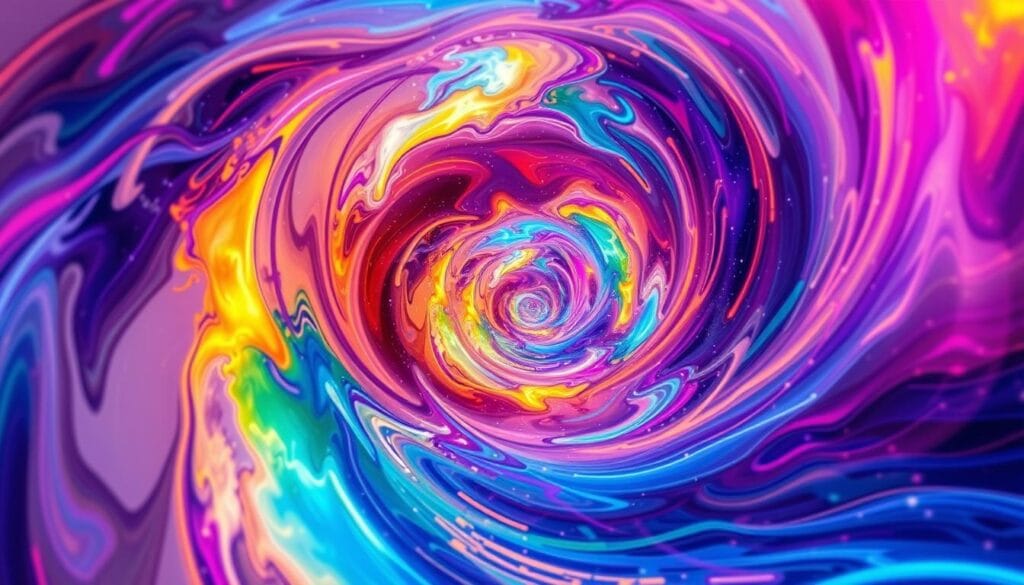
Cognitive psychology shows us how colors affect our minds. Scientists are studying how colors and our mental state are connected.
“Colors are not just visual stimuli, but powerful triggers of emotional and cognitive responses.” – Dr. Angela Roberts, Color Perception Researcher
Studies have found some important things about colors and our minds:
- Blue hues can really help lower stress and make us more productive.
- Warm colors like red and yellow boost creativity and wakefulness.
- Green helps us feel balanced and connected to nature.
Research on how we see colors has given us some interesting facts:
| Color | Psychological Effect | Potential Impact |
|---|---|---|
| Blue | Stress Reduction | Up to 15% decrease in anxiety levels |
| Green | Mental Balance | Improved emotional stability |
| Yellow | Creative Stimulation | Enhanced cognitive flexibility |
Even with these findings, color psychology is still growing. More research is needed to fully grasp how colors affect our brains. The colors around us can greatly affect our mood and performance. This makes colors a valuable tool for improving our lives.
Conclusion: Harnessing the Power of Color for Mental Performance
Your journey through Colors of the Mind shows how color psychology affects mental performance. Studies show that certain colors can boost creativity, focus, and mood. By knowing how colors affect our brains, we can create better environments for thinking.
Choosing colors wisely is more than just picking what looks good. Colors like blue for work and green for calm can change how we feel. They help us concentrate or relax, making them key for growth in work and life.
Colors are more than just what we see; they affect our minds. Using colors wisely can make us more creative, less stressed, and better thinkers. It’s about finding the right colors for you and your goals.
As we learn more about color psychology, using it wisely can give us an edge. Our surroundings are like a canvas, and colors are the paint that can make our minds sharper and more balanced. Let’s use color to reach our highest potential.
FAQ
How do colors actually impact our brain and cognitive functions?
Colors affect our brain through how we see them. This can change our feelings, focus, and creativity. Different colors light up different parts of our brain, changing how we feel and think.
Can specific colors really enhance creativity or concentration?
Yes, research shows that colors can really change how we think. Blue helps us focus and feel calm. Yellow boosts creativity and energy. It’s all about finding the right colors for you.
Are color effects the same for everyone across different cultures?
No, color meanings vary by culture. While some colors mean the same everywhere, our personal and cultural backgrounds shape how we see them. What sparks creativity in one culture might not in another.
How can I practically apply color psychology in my workspace?
To use color psychology in your workspace, pick colors wisely. Use blue for focus, yellow for creativity, and green to calm down. Add these colors through paint, decor, or digital screens to match your goals.
Is there scientific evidence supporting color psychology?
Yes, lots of research backs up color psychology. Studies show how colors affect our brain, mood, and thinking. But scientists are still learning more about these effects.
Can color psychology help with learning and memory?
Definitely. Using colors can help remember things better and make learning fun. Colors help organize information and make it easier to recall.
How quickly do colors affect our mental state?
Colors affect us almost right away. Our brain quickly processes visual info, leading to fast changes in mood and focus. This happens in just a few seconds.
Are digital environments as effective for color psychology as physical spaces?
Yes, digital spaces can also use color psychology. The right colors on screens can improve focus, creativity, and comfort. It’s just as effective as physical spaces.
